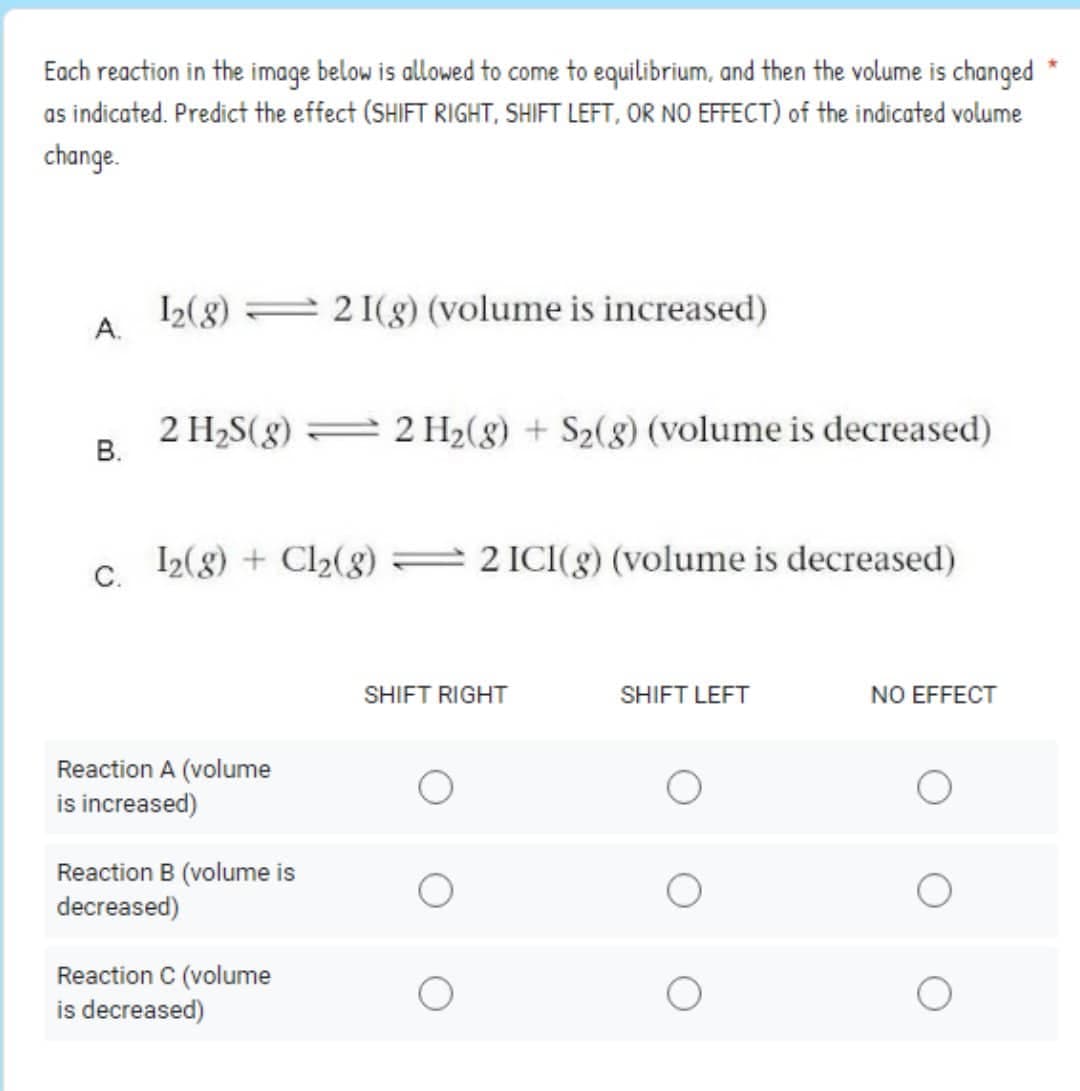Each reaction in the image below is allowed to come to equilibrium, and then the volume is changed as indicated. Predict the effect (SHIFT RIGHT, SHIFT LEFT, OR NO EFFECT) of the indicated volume change. A. 12(8) 21(g) (volume is increased) 2 H₂S(g) 2 H₂(g) + S₂(g) (volume is decreased) B. C. 12(g) + Cl₂(g) = 2 ICI(g) (volume is decreased) Reaction A (volume is increased) Reaction B (volume is decreased) Reaction C (volume is decreased) SHIFT RIGHT SHIFT LEFT NO EFFECT
Each reaction in the image below is allowed to come to equilibrium, and then the volume is changed as indicated. Predict the effect (SHIFT RIGHT, SHIFT LEFT, OR NO EFFECT) of the indicated volume change. A. 12(8) 21(g) (volume is increased) 2 H₂S(g) 2 H₂(g) + S₂(g) (volume is decreased) B. C. 12(g) + Cl₂(g) = 2 ICI(g) (volume is decreased) Reaction A (volume is increased) Reaction B (volume is decreased) Reaction C (volume is decreased) SHIFT RIGHT SHIFT LEFT NO EFFECT
Chemistry by OpenStax (2015-05-04)
1st Edition
ISBN:9781938168390
Author:Klaus Theopold, Richard H Langley, Paul Flowers, William R. Robinson, Mark Blaser
Publisher:Klaus Theopold, Richard H Langley, Paul Flowers, William R. Robinson, Mark Blaser
Chapter13: Fundamental Equilibrium Concepts
Section: Chapter Questions
Problem 89E: At 25 C and at 1 atm, the partial pressures in an equilibrium mixture of N2O4 and NO2 are PN2O4=0.70...
Related questions
Question

Transcribed Image Text:Each reaction in the image below is allowed to come to equilibrium, and then the volume is changed
as indicated. Predict the effect (SHIFT RIGHT, SHIFT LEFT, OR NO EFFECT) of the indicated volume
change.
A.
12(8) 21(g) (volume is increased)
2 H₂S(g) 2 H₂(g) + S₂(g) (volume is decreased)
B.
C.
12(g) + Cl₂(g) = 2 ICI(g) (volume is decreased)
Reaction A (volume
is increased)
Reaction B (volume is
decreased)
Reaction C (volume
is decreased)
SHIFT RIGHT
SHIFT LEFT
NO EFFECT
Expert Solution
This question has been solved!
Explore an expertly crafted, step-by-step solution for a thorough understanding of key concepts.
Step by step
Solved in 2 steps with 2 images

Knowledge Booster
Learn more about
Need a deep-dive on the concept behind this application? Look no further. Learn more about this topic, chemistry and related others by exploring similar questions and additional content below.Recommended textbooks for you

Chemistry by OpenStax (2015-05-04)
Chemistry
ISBN:
9781938168390
Author:
Klaus Theopold, Richard H Langley, Paul Flowers, William R. Robinson, Mark Blaser
Publisher:
OpenStax

Chemistry: Principles and Reactions
Chemistry
ISBN:
9781305079373
Author:
William L. Masterton, Cecile N. Hurley
Publisher:
Cengage Learning

Chemistry
Chemistry
ISBN:
9781305957404
Author:
Steven S. Zumdahl, Susan A. Zumdahl, Donald J. DeCoste
Publisher:
Cengage Learning

Chemistry by OpenStax (2015-05-04)
Chemistry
ISBN:
9781938168390
Author:
Klaus Theopold, Richard H Langley, Paul Flowers, William R. Robinson, Mark Blaser
Publisher:
OpenStax

Chemistry: Principles and Reactions
Chemistry
ISBN:
9781305079373
Author:
William L. Masterton, Cecile N. Hurley
Publisher:
Cengage Learning

Chemistry
Chemistry
ISBN:
9781305957404
Author:
Steven S. Zumdahl, Susan A. Zumdahl, Donald J. DeCoste
Publisher:
Cengage Learning

Chemistry: An Atoms First Approach
Chemistry
ISBN:
9781305079243
Author:
Steven S. Zumdahl, Susan A. Zumdahl
Publisher:
Cengage Learning


Chemistry for Engineering Students
Chemistry
ISBN:
9781337398909
Author:
Lawrence S. Brown, Tom Holme
Publisher:
Cengage Learning